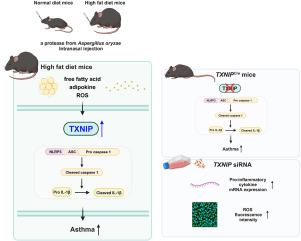当前位置:
X-MOL 学术
›
Redox Biol.
›
论文详情
Our official English website, www.x-mol.net, welcomes your feedback! (Note: you will need to create a separate account there.)
The absence of thioredoxin-interacting protein in alveolar cells exacerbates asthma during obesity
Redox Biology ( IF 10.7 ) Pub Date : 2024-05-17 , DOI: 10.1016/j.redox.2024.103193 Ji-Soo Jeong 1 , Jeong-Won Kim 1 , Jin-Hwa Kim 1 , Chang-Yeop Kim 2 , Eun-Hye Chung 1 , Young-Eun Cho 3 , Eui-Ju Hong 1 , Hyo-Jung Kwon 1 , Je-Won Ko 1 , Tae-Won Kim 1
Redox Biology ( IF 10.7 ) Pub Date : 2024-05-17 , DOI: 10.1016/j.redox.2024.103193 Ji-Soo Jeong 1 , Jeong-Won Kim 1 , Jin-Hwa Kim 1 , Chang-Yeop Kim 2 , Eun-Hye Chung 1 , Young-Eun Cho 3 , Eui-Ju Hong 1 , Hyo-Jung Kwon 1 , Je-Won Ko 1 , Tae-Won Kim 1
Affiliation

|
Obesity is associated with an increased incidence of asthma. However, the mechanisms underlying this association are not fully understood. In this study, we investigated the role of thioredoxin-interacting protein (TXNIP) in obesity-induced asthma. Asthma was induced by intranasal injection of a protease from in normal diet (ND)- or high fat diet (HFD)-fed mice to investigate the symptoms. We measured TXNIP expression in the lungs of patients with asthma and in ND or HFD asthmatic mice. To explore the role of TXNIP in asthma pathogenesis, we induced asthma in the same manner in alveolar type 2 cell-specific TXNIP deficient () mice. In addition, the expression levels of pro-inflammatory cytokines were compared based on TXNIP gene expression in A549 cells stimulated with recombinant human tumor necrosis factor alpha. Compared to ND-fed mice, HFD-fed mice had elevated levels of free fatty acids and adipokines, resulting in high reactive oxygen species levels and more severe asthma symptoms. TXNIP expression was increased in both, asthmatic patients and HFD asthmatic mice. However, in experiments using mice, despite being TXNIP deficient, mice exhibited exacerbated asthma symptoms. Consistent with this, studies showed highest expression levels of pro-inflammatory cytokines in TXNIP-silenced cells. Overall, our findings suggest that increased TXNIP levels in obesity-induced asthma is compensatory to protect against inflammatory responses.
中文翻译:

肺泡细胞中硫氧还蛋白相互作用蛋白的缺乏会加剧肥胖期间的哮喘
肥胖与哮喘发病率增加有关。然而,这种关联背后的机制尚不完全清楚。在这项研究中,我们研究了硫氧还蛋白相互作用蛋白(TXNIP)在肥胖诱发的哮喘中的作用。通过鼻内注射来自正常饮食(ND)或高脂肪饮食(HFD)喂养的小鼠的蛋白酶来诱导哮喘,以研究症状。我们测量了哮喘患者和 ND 或 HFD 哮喘小鼠肺部的 TXNIP 表达。为了探讨 TXNIP 在哮喘发病机制中的作用,我们以相同的方式在肺泡 2 型细胞特异性 TXNIP 缺陷 () 小鼠中诱导哮喘。此外,根据重组人肿瘤坏死因子α刺激的A549细胞中TXNIP基因的表达,比较促炎细胞因子的表达水平。与ND喂养的小鼠相比,HFD喂养的小鼠游离脂肪酸和脂肪因子水平升高,导致活性氧水平升高和更严重的哮喘症状。哮喘患者和 HFD 哮喘小鼠中 TXNIP 表达均增加。然而,在小鼠实验中,尽管 TXNIP 缺陷,小鼠仍表现出哮喘症状加剧。与此一致的是,研究表明 TXNIP 沉默细胞中促炎细胞因子的表达水平最高。总体而言,我们的研究结果表明,肥胖诱发的哮喘中 TXNIP 水平升高是补偿性的,可以预防炎症反应。
更新日期:2024-05-17
中文翻译:

肺泡细胞中硫氧还蛋白相互作用蛋白的缺乏会加剧肥胖期间的哮喘
肥胖与哮喘发病率增加有关。然而,这种关联背后的机制尚不完全清楚。在这项研究中,我们研究了硫氧还蛋白相互作用蛋白(TXNIP)在肥胖诱发的哮喘中的作用。通过鼻内注射来自正常饮食(ND)或高脂肪饮食(HFD)喂养的小鼠的蛋白酶来诱导哮喘,以研究症状。我们测量了哮喘患者和 ND 或 HFD 哮喘小鼠肺部的 TXNIP 表达。为了探讨 TXNIP 在哮喘发病机制中的作用,我们以相同的方式在肺泡 2 型细胞特异性 TXNIP 缺陷 () 小鼠中诱导哮喘。此外,根据重组人肿瘤坏死因子α刺激的A549细胞中TXNIP基因的表达,比较促炎细胞因子的表达水平。与ND喂养的小鼠相比,HFD喂养的小鼠游离脂肪酸和脂肪因子水平升高,导致活性氧水平升高和更严重的哮喘症状。哮喘患者和 HFD 哮喘小鼠中 TXNIP 表达均增加。然而,在小鼠实验中,尽管 TXNIP 缺陷,小鼠仍表现出哮喘症状加剧。与此一致的是,研究表明 TXNIP 沉默细胞中促炎细胞因子的表达水平最高。总体而言,我们的研究结果表明,肥胖诱发的哮喘中 TXNIP 水平升高是补偿性的,可以预防炎症反应。
















































 京公网安备 11010802027423号
京公网安备 11010802027423号